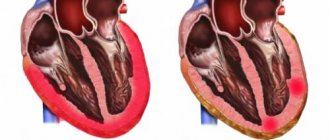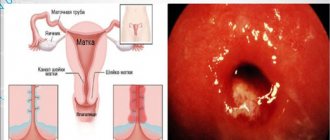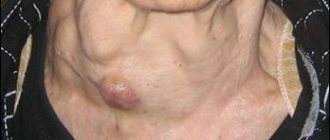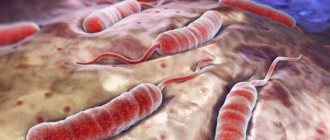Obesity symptoms
The symptoms of obesity may seem obvious to everyone: being overweight. Indeed, this is the most specific sign indicating a problem. Fat deposits are found on the abdomen, back, sides, shoulders, and thighs. Moreover, the muscles of such people are most often weak and underdeveloped.
Other symptoms of obesity include:
- Changes in appearance. People develop a double chin, and men often suffer from gynecomastia (their mammary glands increase in size). The abdomen is covered with fat folds that resemble an apron;
- Often, people with excess body weight experience inguinal and umbilical hernias;
- Patients get tired faster, drowsy, and sweating in such people is increased;
- As the disease progresses, shortness of breath occurs, as the cardiovascular system suffers;
- Due to metabolic disturbances, disruptions occur in the digestive system. Nausea is common and constipation develops;
- The joints and spine suffer from excessive stress and pain occurs;
- Obese people are prone to edema;
- In women, menstrual cycle disturbances are possible; in men, potency suffers. Sexual desire decreases;
- Folds and increased sweating cause the development of skin pathologies, including prickly heat, furunculosis, eczema, pyoderma, acne. Stretch marks appear on the stomach and thighs. High friction areas are particularly affected.
Depending on where fat is deposited, there are three types of obesity. So, if fat is deposited mainly in the upper part of the body, and the figure begins to resemble an apple in shape, then doctors talk about the abdominal type of obesity. This condition is considered very dangerous to health, as it threatens the development of cardiovascular pathologies.
When fat deposits begin to accumulate in the lower part of the body, and the body itself is shaped like a pear, then experts talk about the femoral-gluteal type of obesity. Most often, fat is distributed in this way in females. This type of obesity is dangerous for the development of varicose veins, venous insufficiency and joint pathologies.
As for the third type of obesity, it is called mixed. In this case, the fat is distributed evenly throughout the body.
Depending on the type of obesity, the symptoms of the disease will vary. The differences are expressed in the rate at which body weight increases, as well as in whether a person has problems with the endocrine and nervous system.
Based on this, they distinguish:
- Symptoms of nutritional type of obesity. There is a gradual gain in body weight. Fat is evenly distributed, although sometimes it accumulates more on the thighs and abdomen. The endocrine system works normally;
- Symptoms of hypothalamic obesity. Body weight increases very quickly. Fat is deposited mostly on the buttocks and thighs, as well as on the abdomen. A person experiences constant hunger, which makes him overeat. The increase in appetite is especially noticeable in the evening. Such people drink a lot of water because they are thirsty all the time. Patients get up at night to eat. Patients experience tremors of the limbs and complain of dizziness. Since weight is gained quickly, the skin cannot withstand such stress. Pink stretch marks form on it. Women often suffer from infertility, facial hair may grow, and the menstrual cycle is disrupted. As for men, their sexual function primarily suffers. The following pathologies are observed from the nervous system: frequent headaches occur, insomnia appears. Blood pressure in patients is most often elevated;
- Symptoms of endocrine obesity. If the functioning of some endocrine glands is disrupted, the patient may begin to gain weight. Fat deposits are distributed unevenly throughout the body. Women acquire masculine features; in men, on the contrary, their breasts begin to enlarge and stretch marks appear on the skin. In addition, the person suffers from symptoms associated with one or another disease of the endocrine glands;
- Symptoms of lipomatosis. This form of obesity needs to be considered separately, since body weight increases due to hyperplasia of benign fat cells. Lipomas appear on the human body, which do not hurt and have a symmetrical shape. Men are more susceptible to lipomatosis. A special form of the disease is Dercum lipomatosis, which causes itchy, painful lipomas to appear on the arms, legs, and body.
Causes and factors contributing to obesity
Obesity most often begins to develop due to the fact that there is a disruption in the normal balance between energy expenditure and the supply of this energy along with food. It has been established that the main cause of obesity is overeating. It is this that in 90% of cases contributes to the fact that a person begins to gain weight. The abundance of kilocalories received from food cannot be 100% consumed by the body. Therefore, the excess turns into fat and is deposited in the so-called fat “depots”. Such depots are mainly subcutaneous fat, the abdominal wall and internal organs.
Over time, fat reserves increase and body weight increases, which negatively affects health. It has been proven that only 5% of obesity cases are caused by metabolic disorders.
A provoking factor that has a direct impact on a person’s eating behavior is a dysregulation of the hypothalamic-pituitary-adrenal system. The more actively it works, the higher the rate of production of ACTH and cortisol. At the same time, the somatotropic hormone responsible for the breakdown of fats begins to be produced in smaller quantities. At the same time, the level of insulin in the blood increases, and the absorption of thyroid hormones is disrupted. All this leads to an increase in appetite and a slowdown in the process of fat absorption.
So, the main cause of obesity is overeating.
However, we can separately highlight some factors that contribute to the gain of extra pounds, among them:
- Low physical activity, sedentary lifestyle;
- Genetic predisposition to enzymatic failures. This is expressed in excessive activity of the lipogenesis system and low activity of enzymes responsible for the breakdown of fats;
- Irrational diet plan. Fat begins to actively accumulate when carbohydrates, salt, fats, and sugars are present in large quantities in the diet. Alcohol abuse and eating in the evening, especially before bedtime, are dangerous;
- Diseases of the endocrine system, including Cushing's disease, hypogonadism, hypothyroidism and insulinoma;
- Overeating due to stress;
- Sometimes obesity is caused by a person's physiological state. For example, women eat more than normal during pregnancy, while breastfeeding, and then it becomes a habit;
- Often the reason that a person overeats is taking hormonal drugs or treatment with psychotropic drugs.
Depending on the cause that led to obesity, primary and secondary obesity are distinguished. Primary develops due to the influence of some external factor: overeating, low physical activity, predominance of fats and carbohydrates in food, etc. Often people have a family predisposition to obesity.
Secondary obesity is a gain in body weight due to hereditary diseases (Gelino syndrome, adiposogenital dystrophy, etc.) or due to cerebral pathologies (mental disorders, brain tumors, etc.).
Nutrition
First of all, to combat excess weight, the doctor will advise you to normalize your diet. Without this, fatty tissue will continue to accumulate in the body, increasing weight.
Listen to the advice of nutritionists:
- the ideal option is a low-calorie but balanced diet No. 8 according to Pevzner;
- increase the amount of plant fiber and dietary fiber in the diet;
- eat small meals 5-6 times a day;
- give up fast foods and snacks on the go;
- minimize salt and spices;
- replace sugar with sweeteners;
- exclude fried, pureed, chopped foods;
- daily calorie content - no more than 1,900 kcal.
To create your own menu for the week, you can use the table below.
It’s not enough to prepare these dishes; you need to constantly monitor the portion size and daily calorie intake. This is the only way to stop the development of obesity.
Obesity and type 2 diabetes
Obesity and type 2 diabetes are closely related, since the presence of extra pounds significantly increases the risk of developing this dangerous disease. It has been established that the third degree of obesity increases the likelihood of developing diabetes by 10 times. Type 2 diabetes itself is an acquired and non-insulin dependent disease.
It is the lifestyle that leads to excess weight gain that becomes a trigger for increased blood sugar levels. However, with adequate physical activity, glucose entering the bloodstream is transformed into energy, since muscles need it to work. If a person leads a sedentary lifestyle and consumes a large amount of carbohydrates, then more insulin will be needed to process glucose. Excess sugar contributes to the formation of fat not only in the subcutaneous layer, but also around the internal organs. Naturally, to produce insulin, the pancreas has to work harder, which leads to depletion of the organ. Thus, against the background of overeating, a person gains extra pounds of fat and at the same time develops diabetes mellitus.
To prevent this situation, you need to properly organize your diet, stop eating large amounts of carbohydrates, and also increase physical activity on the body. If you take the necessary measures in time, type 2 diabetes will be eliminated and insulin therapy will not be required.
Diagnostics
When contacting an endocrinologist to confirm or refute the diagnosis, you will have to undergo an examination, a number of tests and laboratory tests:
- weighing, measuring height, calculating BMI, clarifying the location of fat deposits;
- blood test for cholesterol, sugar, biochemistry;
- analysis of gastric juice;
- fluoroscopic absorptiometry (DEXA);
- ultrasonic densitometry;
- MRI reveals the amount of visceral fat.
In addition, differential diagnosis is carried out to identify concomitant pathologies: hypothyroidism, polycystic ovary syndrome, pancreatic tumor, etc.
Obesity levels
There are four degrees of obesity, each of which is characterized by a specific set of characteristics. The degree of obesity is determined by calculating the body mass index. The higher the degree of obesity, the greater the risk of developing various pathologies.
Obesity 1st degree
We speak of stage 1 obesity when a person’s BMI is high and ranges from 30.0 to 34.9. If a person has the first degree of obesity, then he already needs a medical examination followed by the development of an individual treatment program. It has been established that a BMI exceeding 30 poses a direct threat to health. Although many patients at this stage of obesity may have absolutely no complaints related to the condition of their body.
However, stage 1 obesity is a reason for a thorough examination and weight loss.
In addition to the fact that a person’s body weight will increase, the following symptoms may develop:
- The occurrence of unexplained weakness;
- Fatigue, excessive sleepiness;
- Increased sweating;
- Increased irritability;
- Dissatisfaction with appearance;
- Nervousness;
- Dyspnea;
- From the digestive system, disorders such as constipation and periodic nausea cannot be excluded;
- Edema may occur, which is localized mainly in the lower extremities;
- The first problems with the joints and spine begin to appear, which are expressed in low-intensity pain.
When changing lifestyle at the first stage of obesity development, all pathological processes are reversible.
Obesity 2 degrees
Type 2 obesity is diagnosed in a patient if his BMI is very high and is in the range between 35.0 and 39.9. At the same time, a person’s body weight, compared to normal, increases by 30-40%.
More massive obesity leads to the fact that all the symptoms of ill health that bothered the patient with the first degree of obesity begin to intensify. Weakness increases, the person is increasingly in a depressed mood. Nausea is accompanied by bitterness in the mouth, which indicates disturbances in the functioning of the liver and gallbladder.
Joint pain intensifies and the load on the spinal column increases. Already at this stage of obesity development, it is possible to increase blood pressure and disrupt the functioning of the heart muscle. Swelling of the lower extremities increases and can persist throughout the day.
Obesity 3 degrees
Obesity of the 3rd degree is spoken of if the body mass index is excessively high and slightly exceeds 40. In this case, there is an increase in actual body weight compared to the ideal by 50-99%. To determine ideal body weight, middle-aged men need to subtract 100 from their own height in centimeters, and women – 110.
As for the symptoms of stage 3 obesity, they are as follows:
- Disturbances in the functioning of the heart and blood vessels progress (arterial hypertension, tachycardia increase, muffled heart sounds are heard);
- The respiratory system suffers with the development of chronic pulmonary heart disease and the formation of respiratory failure;
- There are disturbances in the digestive system;
- The liver parenchyma is permeated with fatty infiltrates, which complicates the normal functioning of the organ;
- Sometimes pancreatitis and chronic cholecystitis develop;
- The pain in the spine intensifies, and the ankle and knee joints suffer.
In women, third-degree obesity most often leads to menstrual irregularities, sometimes menstruation stops completely. In men, potency always deteriorates.
Obesity 4 degrees
Obesity of the 4th degree is characterized by a significant excess of BMI (from 40 or more). In this case, the actual weight of a person is twice as much as the ideal body weight. Often such patients weigh more than 150-200 kg. There are cases when people's body weight reached 300 kilograms or more.
With such severe obesity, absolutely all human organs and systems suffer. Often such people are not even able to take care of themselves independently. Patients develop multiple severe pathologies, including diabetes mellitus, endocrine disorders, heart failure, etc. The skin suffers greatly, which a person is not able to hygienically treat on his own. Bedsores form due to bed rest. With 4 degrees of obesity, 100% of patients receive a certain disability group.
People with such excess body weight need urgent treatment, since in its absence a quick death is inevitable.
Symptoms
How to recognize stage 1 obesity before going to the doctor?
- BMI is more than 30 but less than 34.9.
- Women's waist circumference is more than 80 cm, men's - more than 94 cm.
- With the abdominal type, the belly grows; with the gynoid type, the butt and hips increase.
- Portion sizes are gradually increasing, hunger is tormenting more and more often and more intensely.
- The first signs of shortness of breath appear when you cannot climb to your floor or walk a couple of stops without it.
- The figure looks blurred, shapelessness appears.
The disease is closely related not only to weight, but also to height. If a girl with a height of 180 cm weighs 80 kg, this is normal. But such a parameter with a height of 150 cm may already indicate the development of the disease.
Photo of obesity 4 degrees
This disease should not be neglected. What can people expect who don’t think about their health? For clarity, here is a photo of stage 4 obesity:
How is obesity treated?
Treatment of obesity involves a complex effect on the body. It is important not only to immediately reduce body weight, but also to maintain it at normal levels. Losing body weight will have a positive impact on a person’s overall health. However, the weight should come off gradually. So, in the first six months of treatment you should not lose weight by more than 10% of your total body weight. If this goal has been achieved, then the fight against obesity can continue.
Non-drug treatments for obesity are as follows:
Following a low-calorie diet
If the calorie content of the daily diet is reduced to 1500 kcal, then on average in six months it will be possible to get rid of 8% of body weight. If a person is moderately obese, then it will be enough for him to subtract about 500 kcal from his total diet to start losing weight. In more advanced cases, it will be necessary to reduce the calorie content of the diet by an average of 1000 kcal. In this case, you will be able to lose from 0.5 to 1 kg in 7 days.
It is possible that the patient will be recommended a very low-calorie diet with a daily intake of 800 kcal. But such schemes can only be implemented for a short period of time, and the patient himself must be under medical supervision. You should not maintain such a diet for more than 3 months.
It is possible to carry out therapeutic fasting with a maximum restriction of the daily diet. However, this technique is applicable only in a hospital setting with 3-4 degrees of obesity.
As a rule, people manage to lose weight quite quickly, but the main danger is that subsequently they begin to quickly gain back the lost kilograms, eventually reaching a higher degree of obesity. To prevent this from happening, a change in eating behavior in general is required with mandatory lifestyle correction.
Read more: Diet for obesity degrees 1, 2, 3 and 4
Physical exercise
Physical activity makes it possible to enhance the effect of following a diet. In addition, an active lifestyle can reduce the risk of developing a huge number of diseases, and, first of all, heart and vascular diseases. The selection of exercise therapy is carried out on an individual basis and depends on the level of training of a person and on his state of health. Almost all obese patients without exception are recommended to walk for 30-45 minutes a day or more.
As for the medical correction of obesity, it comes down to taking medications.
They are divided into two groups:
- Anorectic drugs that either increase the feeling of fullness or suppress appetite.
- Drugs that reduce the absorption of nutrients in the intestines.
Read more: 10 most popular diet pills
They are taken only if you follow a diet and exercise. Self-treatment is strictly prohibited, as these medications have a lot of side effects. In addition, some of them can cause addiction.
The most preferred drugs at the moment are the drugs Meridia (Sibutramine) and Xenical (Orlistat). The action of Meridia is based on the fact that the patient feels full faster. This causes him to eat less food. Xenical, in turn, contributes to a deterioration in the absorption of fats in the intestines.
We should not forget about psychological assistance for patients with obesity, in addition to the fact that such people are prone to depression and neuroses, they need correction of eating behavior and lifestyle. Psychotherapeutic conversations and hypnosis are effective in this regard.
Surgical treatment of obesity is not excluded. For this purpose, part of the small intestine is removed, which reduces the absorption of nutrients by the body. In some cases, gastroplasty is performed, during which a small stomach is formed.
Interventions such as gastric bypass and gastric banding are also popular in world practice. Thanks to these interventions, people quickly lose up to 20-30 kg, but the long-term consequences of such operations remain poorly understood. Therefore, this type of treatment is applicable exclusively to patients with 3-4 degrees of obesity and only in cases where other methods of combating excess weight do not bring a positive effect.
On the subject: Are injections for weight loss a scam? Advantages and disadvantages
Treatment
Treatment of obesity can be carried out using conservative and surgical methods. Conservative therapy is effective at stages 1-3 of obesity and includes:
- developing a diet for a specific patient, based on the needs and condition of his body;
- physical therapy classes;
- in some cases, the prescription of drugs that reduce appetite (at stages 2-3).
Surgical treatment is necessary for morbid obesity, as well as in cases where conservative methods do not produce results or the patient has developed diseases that pose a threat to his life.
Operations can be divided into 2 large groups:
- Aimed at reducing the absorbable surface area of the small intestine. As a result, the body absorbs fewer energetically valuable substances.
- Reducing stomach volume. After surgery, the patient begins to feel full with small portions of food. During surgery, part of the stomach may be removed, or the stomach may be tightened using special tapes or a bandage.
Surgery is used in extreme cases when there are no alternatives. As a result of the operation and subject to all the doctor’s recommendations, the patient is able to significantly reduce weight, regain ability to work and resume his usual lifestyle.
The operation is not performed if the patient is dependent on alcohol/drugs or the following mental illnesses (therefore, a consultation with a psychiatrist is required before surgery):
- schizophrenia;
- severe depression;
- borderline personality disorder;
- compulsive overeating.
Such patients are unable to control their eating behavior, and after surgery this is simply necessary. Also, surgery is not performed for endocrine obesity.










